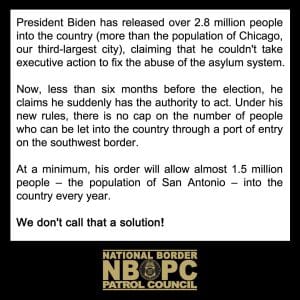National Border Patrol Council Rebuttal to AP Analysis of Border Patrol OT
February 6, 2012 – On Sunday, millions watched the New York Giants and the New England Patriots in Super Bowl XLVI. Some watched their teams and hoped for victory, while others watched because they enjoy football and to see which team’s strategy leads them to victory. Football fans understand that neither the Giants nor the Patriots would have made it to the Super Bowl if the teams decided to play less defensive players against teams that were less of a threat. Fans also know that the Giants would have lost the game if they decided to take the entire defensive line out of the game in the last minute in an effort to save money because they were winning. This same concept applies to the United States border and may help clear up any confusion for those who read the recent Associated Press article written by reporter Alicia A. Caldwell, titled “AP Analysis: Border Patrol OT up as arrests drop.”
Northern border versus southern border
In the AP article, Caldwell questions the agency’s use of the same overtime system for both borders (northern and southern). Caldwell presents the data regarding the number of agents and the total dollar amount paid in Administratively Uncontrollable Overtime (AUO). According to the data, AUO doubled when the number of agents doubled. This should come as no surprise considering AUO was designed to save the government money while at the same time providing 24/7 coverage on the border. Although the number of agents doubled, the Border Patrol still does not have enough agents to provide 24/7 coverage due to the existing strategy of defense and the lack of a good offense. As a result, AUO is still necessary to maintain a defensive line.
Caldwell presents the number of arrests for the northern and southern border and suggests the borders should be treated differently due to a variance in apprehensions. Although the southern border may have more apprehensions, both borders pose the same threat and require the same defensive line, regardless of apprehensions. The article fails to analyze the fact that there are only 2,237 agents responsible for defending 4,000 miles of northern border, whereas there are nearly 15,000 agents responsible for defending 2,000 miles of southern border. The so-called analysis seems to ignore how only 14% of the Border Patrol is employed to defend 65% of the U.S. border, a majority of which is very remote, out-of-sight from the general public, and not always patrolled due to insufficient staffing.
Another notable factor is the restrictions imposed on the authority of agents implemented by career politicians in the Border Patrol and Customs and Border Protection (CBP). In other words, when Border Patrol agents are directed to stay in one place, or prohibited from performing operations at transportation hubs or areas where illegal aliens are known to congregate, then apprehensions will decrease. In 1995, to justify Operation Gatekeeper with statistics and prove the success of the operation, Border Patrol management implemented numerous restrictions in order to decrease apprehensions in areas away from the border. The number of restrictions grew over the years with each new political appointed chief and commissioner. As expected, the number of apprehensions also decreased.
Although those factors impacted the number of apprehensions, the need for AUO on both borders continues for many reasons. Changes in policies and methods related to completing the necessary paperwork and entering detainees into computer systems have changed and substantially increased the amount of time it takes to process them. More importantly, while the number of people entering the country to seek employment may decrease, the threat does not decrease as the number of smuggling operations related to weapons, narcotics, and other contraband continues regardless of any proclaimed success.
Four shifts
According to the article, Border Patrol Deputy Chief Ronald D. Vitiello’s said: “the Border Patrol is considering four shifts of ten hours. For those who are unaware, under four shifts, the number of agents will decrease during certain hours. Unfortunately, under the leadership of Chief Fisher, many stations implemented four shifts regardless of the decrease in manpower because under Chief Fisher’s command, the budget takes priority over border security. As such, this is just one more factor to consider when discussing a decrease in apprehensions. Unlike football, where everyone can watch when the other team makes a touchdown, successful smuggling operations occur in remote areas, often go unnoticed, and are rarely viewed on a widescreen. Unless of course the smuggler films how he lifts the “secure” border fence with a jack like the recent YouTube video posted under the “Secure Borders News” section of www.nbpc.net.
More importantly, a reduction in the number of agents is unsafe and increases the likelihood of a U.S. Border Patrol agent being killed in the line of duty, regardless of what border they are defending. Although apprehensions have decreased, the number of agents dying in the line of duty will not decrease as long as smugglers have more rights than agents, and the costs of securing the border are more important than providing a secure border.
Law Enforcement Availability Pay
According to the article, Sharon Snellings, Customs and Border Protection’s (CBP) deputy assistant commissioner of human resources said, “agency officials also are looking at shifting to another type of overtime system used by other law enforcement agencies that she said could save the agency about $70 million a year.”
The overtime system mentioned by Snellings is Law Enforcement Availability Pay (LEAP). LEAP only provides 25% on the base salary for an infinite amount of extra work. LEAP is primarily used for criminal investigators and special agents who have a higher journeyman level pay than Border Patrol agents. Yet, the CBP proposal did not include increasing the journeyman level to match the level paid to other federal law enforcement officers under LEAP. LEAP was specifically designed to compensate investigators for the time they are available in an on-call status due to the variances in manpower, shifts, and the type of work performed. It clearly was not intended for 24/7 operations that required coverage at all times.
CBP claimed the purpose of the pay reform proposal was to provide uniformity with overtime systems within CBP. However, the CBP proposal does not change the overtime system used by CBP Officers. Instead, CBP officers continue to earn overtime under the Customs Officer Pay Reform Act (COPRA), which provides higher overtime and premium rates. So, uniformity under the CBP pay reform means CBP Officers will continue earning higher rates of overtime and premium pay, while Border Patrol agents will receive an immediate seven percent cut in pay and will be required to work excessive hours for free (Pay Reform Comparison Chart).
Alleged savings
Snellings claims a savings, but fails to mention how the savings will be used to provide a 25% pay increase to high-ranking management officials in CBP by placing them under LEAP, even though the majority of their job is administrative and requires little overtime. Much of the savings will undoubtedly go towards the unnecessary, redundant layers of management that have been added over the years. For example, since 2000, Border Patrol created two additional levels of management to the station chain of command: field operations supervisor and shift operations supervisor. Recently, Border Patrol announced the large station command structure, which multiplies the number of management positions in every large station. Currently, Border Patrol is preparing to convert the station commander position to the Senior Executive Series (SES), which will result in every level of management receiving a pay increase, while they decrease the pay of their subordinates.
At the sector level, the Border Patrol added a division chief position between the assistant chief and deputy chief. Border Patrol also implemented a large sector command, which multiplied even more management positions. In addition, the Border Patrol created an adjutant position that is filled by a supervisory border patrol agent to serve as a secretary and chauffer for sector chiefs. Finally, in an attempt to be like the Department of Defense, the Officer of Border Patrol implemented the joint command structure, which added a new joint command chief to manage the many sector chiefs.
Therefore, if the Administration or Congress is interested in saving money in the Border Patrol, the first place to look is the excessive number of management positions that the Border Patrol created in the past ten years. In CBP, the Administration or Congress should demand a review of the many parallel kingdoms that were created when Border Patrol was placed in CBP. Two prime examples are Mission Support and Labor and Employee Relations. These two components compete with one another and should be merged to reduce the multiple layers of management that exists within each component.
The National Border Patrol Council and its members are committed to saving the government money and reducing the debt; however, these measures should not come at the expense of rank-and-file Border Patrol Agents by having them become the only federal employees in CBP sacrificing a seven percent cut in pay and working endless overtime hours for free. This is exactly what will happen if Border Patrol agents are placed under LEAP. There are many other ways to stop excessive spending in CBP, but none of them will ever happen because they involve reducing the unnecessary layers of management that continue to grow at an alarming rate and eliminating or merging some of the parallel kingdoms that exist within CBP.
Months ago, the National Border Patrol Council proposed an alternative overtime system to the leadership of the Border Patrol and CBP. Under the proposed plan, CBP would acquire more flexibility and reduced costs related to overtime. However, CBP would not be able to make Border Patrol agents work endless hours for free. Remarkably, Border Patrol and CBP were not interested and instead continue to promote a proposal with misleading statements about uniformity and imaginary savings. For this reason, the NBPC is working with Congressman Silvestre Reyes to develop a better alternative to the impractical, inequitable, and punitive CBP proposal. The alternative must ensure Border Patrol agents are properly compensated for the endless hours they work to defend the country from the constant threat posed by smugglers, terrorists, and cartels.
For more information please contact George McCubbin, president at gmccubbin@nbpc.net.
###
The National Border Patrol Council is a professional labor union representing more than 17,000 Border Patrol Agents and support staff. The NBPC was founded in 1965, and is recognized as one of the most effective labor organizations in the Federal sector.


